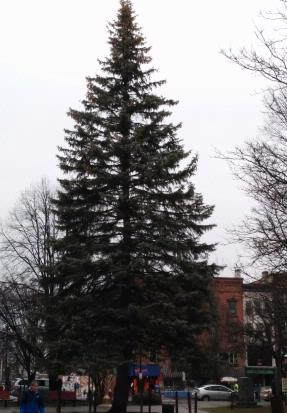
On Christmas day I enact my most gratifying statement of rebellion against the dominant paradigm I haul the Christmas tree out of the house, cut off the branches and throw it in the brush pile on top of several previous years’ trees. The boarders don’t notice as they’re in grandparent land until the New Year. The cats, kids and boss love the it, but the dying tree as a symbol is a funny thing. And it is dying, not dead, because unlike animals many of the tree’s cells are still going about their business.
We choose fir trees as a symbol because they’re nice and green in the winter. They give us a little lift around the solstice: spring is on its way.
As an evolutionary lineage conifers are much older than the flowering plants that dominate most of the planet. This dominance is a relatively new development; 100 million years ago non-flowering plants were everywhere. Dinosaurs couldn’t have given flowers for Valentine ’s Day, but they could have had a Christmas tree. They predated Christ, so this seems unlikely.
Flowers house the reproductive tissues of most plants we’re familiar with. In the standard story a bee lands on a flower, picks up some pollen, flies over to another flower and deposits the pollen on the stigma. The pollen then grows a long tube to deposit the sperm near the ovule: plant sex. The bee takes a little nectar home to make honey and the plant’s ovary swells up to make a lovely fruit that attracts animals to spread the seeds.
Conifers were reproducing just fine before the evolution of the flower, but they didn’t make fruit and there was no honey. Poor dinosaurs had no honey, fruit, or flowers. They didn’t have the Tea Party though, so they had that going for them.
Instead of flowers, conifers grow separate male and female cones. The male cones release lots of pollen: millions of individual pollen grains get spread by the wind in the hopes that they will land in a female cone. If you look at a pine pollen grain under a microscope you will observe miniature “wings” that help it glide to its destination. The chances for any individual pollen grain are vanishingly small. The extraordinary amount of pollen compensates for the lack of directed delivery system (insects). It’ also why parking under a conifer when it’s releasing pollen is a bad idea. No one likes pine sperm delivery systems on their cars.
Strangest to me is the time delay between the pollen grain getting to the female cone, pollination, and fertilization when the sperm and egg actually fuse. The process can take more than a year. In most flowering plants pollination and fertilization happen very quickly. For instance in corn the pollen grows the length of the silk in less than a day.
Flowers, fruit and partnering with insects are a huge evolutionary advantage. Some flowering plants even pollinate themselves (not a sin for a plant, I checked). This, at least in part, accounts for why flowering plants now dominate.
We choose to celebrate this time of year with an evolutionary relic. A group of plants that were around long before mammals evolved and will probably be here long after we’ve extinguished most life. Maybe it is a good symbol of life returning after all.


